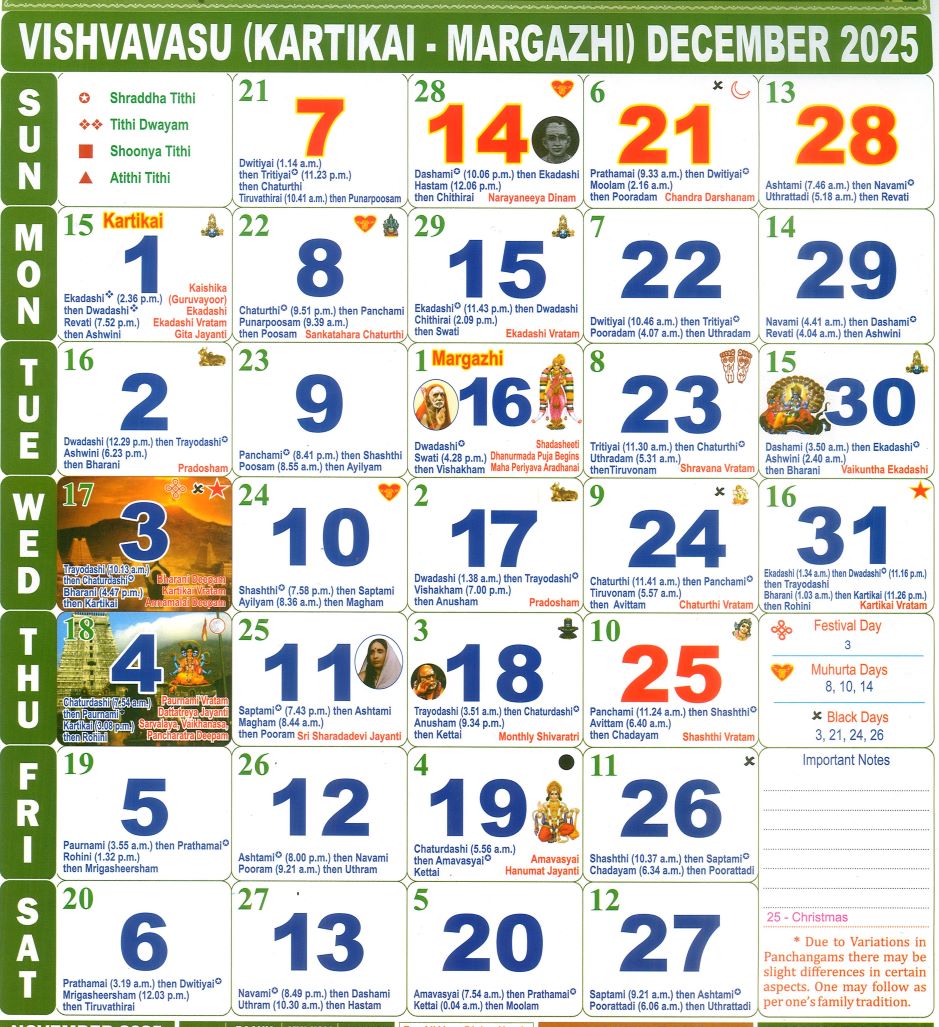| Event | Month | Date |
|---|---|---|
| Amavasai | December | 19 |
| Pournami | December | 4 |
| Sankatahara Chaturthi | December | 8 |
| Sashti | December | 25 |
| Thiruvonam | December | 23 |
| Ekadashi | December | 1 & 15 & 30 |
| Pradosham | December | 2 & 17 |
| Shivratri | December | 18 |
| Karthigai | December | 3 |

| Date | Day | Govt. Holiday |
|---|---|---|
| 25 | Thursday | Christmas |
| Date | Day | Festival | Religion |
|---|---|---|---|
| 3 December, 2025 | Wednesday | Karthigai Deepam | Hindu |
| 24 December, 2025 | Wednesday | Christmas Eve | christian |
| 25 December, 2025 | Thursday | Christmas | christian |
| 31 December, 2025 | Wednesday | New Year Eve | christian |
| Date | Day | Remarks |
|---|---|---|
| 8 December, 2025 | Monday | |
| 10 December, 2025 | Wednesday | |
| 14 December, 2025 | Sunday |

December marks the tail end of Karthigai and ushers in the most spiritually potent Tamil month Margazhi. This month, spanning mid-December to mid-January, is completely dedicated to spiritual practices, bhakti, and devotion to Lord Vishnu. Margazhi is especially revered for early morning prayers, Tiruppavai recitation by Andal devotees, and special Margazhi bhajans in temples. In temples like Srirangam, Thiruvallikeni, and Kanchipuram, Vaikunta Ekadasi is celebrated in grandeur, where devotees enter the ‘Sorga Vasal’ (Gateway to Heaven), a symbolic spiritual event believed to remove karmic blocks.
Astrologically, Margazhi is not used for marriages or new ventures but is considered ideal for prayer, penance, and self-realization. The Sun is said to be in Dakshinayana (southern solstice), and the Earth’s spiritual vibration is higher during the early morning hours. Devotees use this month to wake early, bathe before sunrise, and engage in Nama Sankeerthanam (chanting the divine name). The planetary placements support deep spiritual work and reflection.
Vaikunta Ekadasi, usually falling in late December, is the most significant Vaishnavite festival in Margazhi. Thousands queue for darshan in Vishnu temples to walk through the Sorga Vasal, seeking liberation from the cycle of rebirth. Fasting, silence, and continuous chanting are common practices observed on this holy day. In temples, Utsavams (festivals) are conducted with grand poojas, offering special prayers to Lord Vishnu. This day is considered one of the holiest and is believed to give devotees access to spiritual realms and eternal peace.
Another major observance during Margazhi is the Tiruppavai recitation by devotees of Andal, who sang her devotional hymns to Lord Vishnu. It is believed that this practice invites divine blessings and aligns one’s life with higher spiritual purposes. People also engage in Kirtans, bhajans, and early morning temple visits, which are all considered essential to accumulate positive karma and spiritual growth. As the month concludes and Thai (the next Tamil month) begins, people look forward to the celebration of Pongal.
The Tamil monthly calendar holds significant cultural, spiritual, and practical value in Tamil households. Rooted in Vedic astrology, it serves as a guide for important life events, religious rituals, and even day to day activities. The Panchangam, which is a core part of the Tamil calendar, provides insights into the auspicious timings (Muhurtham) for ceremonies like weddings, housewarming, and starting new ventures. By following the lunar and solar cycles, the calendar helps align daily actions with favorable cosmic energies, ensuring a life of peace and prosperity. It’s also crucial for determining fasting days, festivals, and special observances tied to the Tamil tradition.
In Tamil culture, the calendar is more than just a timekeeping tool, it's an embodiment of the community's religious practices and rituals. Important festivals such as Pongal, Tamil New Year, and Aadi Perukku are marked on the calendar, serving as reminders of when to perform specific religious duties, make offerings to deities, or celebrate with loved ones. For many, it is customary to keep the calendar in homes and temples, serving as a constant connection to spirituality and tradition. The observance of specific lunar days and Nakshatras is thought to bring blessings and prosperity, making the calendar a daily point of reference.
The usage of the Tamil monthly calendar extends beyond astrology and religious observance. It is often employed for agricultural planning and a community that is deeply connected with nature. The calendar provides information on seasonal cycles, which is especially useful for farmers who rely on lunar phases to plant or harvest crops. Additionally, the calendar is an essential tool for family planning, as it is used to select the best days for auspicious events based on the planetary positions and astrological charts. Despite modern advancements, the Tamil monthly calendar remains integral to preserving the cultural heritage, maintaining community bonds, and upholding age-old customs that continue to shape everyday life.
The Tamil Monthly Calendar is a traditional calendar system followed by Tamil people in South India. It is based on the Tamil solar calendar and is widely used to determine auspicious dates for various cultural, religious, and social events. This calendar system has a rich history and cultural significance.
You can also find Ashtami and navmi dates in monthly calendar along with Viratham dates (Important fasting dates)
The Tamil Monthly Calendar serves as a cultural and spiritual guide for the Tamil community, helping them plan their lives and celebrate their traditions with devotion and joy.
A Tamil monthly calendar typically includes important astrological details such as the Panchangam (lunar and solar calendar), which provides information about the Tithi (lunar day), Nakshatra (star), Rahu Kalam, Yamagandam, and Auspicious Timings (Muhurtham). It also lists festivals, religious observances, and special days like Ekadashi, Pournami, and Amavasya. The calendar may display details about planetary positions, and horoscopes for the month. Additionally, it includes key agricultural dates and local cultural events. Tamil calendars also highlight lunar months like Chithirai, Aadi, and Thai, providing a spiritual connection to Tamil traditions.